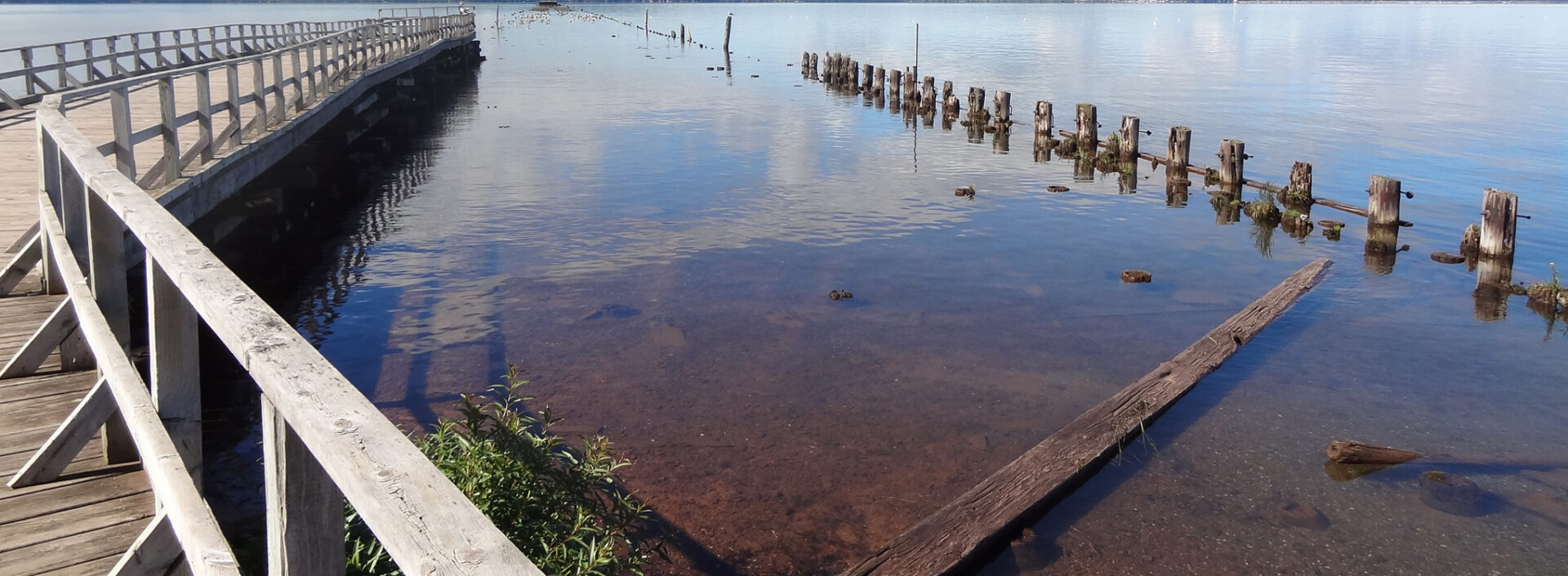Different Types of Waves and Currents and How They Form
Waves moving toward the shore
As waves travel toward shore, they shoal. As waves shoal, the distance between wave crests decreases and the wave heights increase. When a wave gets too steep, it begins to break a bit. On rough days, the breaking tops of waves can be seen all over the lake. As waves get close to shore, the way in which they break varies depending on the shape of the shoaling lakebed.
A steep nearshore lakebed slope will cause approaching waves to rise quickly to a height dependent on water depth, and then plunge quickly. These waves provide the most exciting, but shorter ride for surfers. A more gentle lakebed slope will cause approaching waves to gradually spill their energy, providing a longer, easier ride for surfers. The most gentle lakebed slope will cause a surging of the breaking wave onto the beach…an uninteresting situation for surfers.
Water at the shoreline with somewhere to go
As waves approach shore, they drag some of the water with them, assisted by the wind when it is blowing onshore. This excess water piles up between the breakers and the beach at a level higher than the lake level (sometimes elevated as much as 10 to 20 percent of the breaking wave heights). The steeper the beach slope, the wider the surf zone, the higher the waves, the higher the water will pile up. The surf zone is the area between the breaking waves and the beach where waves run up and rush back into the lake. Gravity rules that the water that comes ashore must return offshore. The elevated water moves from the surf zone inside the breakers towards the lower water level beyond the breakers. This water moves either offshore as a return flow (sometimes called an undertow) under the breaking waves, or along the shore as a current that then turns offshore as a rip current.
Undertow
Usually, this flow is dispersed along the shore and moves lakeward in the lower half of the water column beneath the waves with the highest velocities close to the lakebed between the breakers and shore. Under mild conditions with small to moderate waves (less than two feet high to three feet high), this return flow is not usually a problem for agile swimmers and waders, except sometimes for small children. The undertow is strongest when the waves are high and approaching nearly perpendicular to shore.
Longshore currents
Longshore currents may flow in one direction along the shore between the breakers and the shore. These currents may form circulatory patterns, leaving the shore in narrow rip currents and returning to shore as dispersed flow with the breaking waves. The longshore current is strongest when the waves are high and approaching at a greater angle from the perpendicular to shore. If you are standing on the beach, facing the water, and the waves are approaching at an angle to the shore from the right, the longshore current is probably moving in one direction towards your left. The highest velocities in a longshore current are typically near the water surface and nearer the breakers than the shore. Longshore currents can be escaped by swimming towards the shore and/or wading to shore.
Rip currents
Rip currents occur where a longshore current meets a physical barrier such as a peninsula, headland, long groin, harbor breakwater, nearshore reef, or shoal, and is deflected lakeward. These currents also occur along an open beach where there is less resistance to lakeward flow, such as places where the breaking waves are lower, or where there is a gap or trough in the nearshore sand bars. Once a rip current is established, it can scour its own channel through the bars and be a relatively stable current until wave conditions change. Rip currents are usually narrow. Swimmers can escape them by swimming perpendicular to the flow (parallel to shore) a short distance. For more information see ripcurrents.noaa.gov
How strong are nearshore currents?
Longshore currents may be moving at two to four miles per hour under conditions that include breaking waves that are three to eight feet high and approaching shore at roughly 20 degrees from the perpendicular to shore. Even though an adult can normally wade in these currents, such high velocities can be fatiguing and sweep a person along the shore towards a rip current. Longshore currents can also be dangerous at lower speeds of 0.2 to one mile per hour under conditions that include three to six feet high breakers approaching shore at roughly five to 15 degrees from the perpendicular. People have drowned under these lesser conditions. Rip currents can sometimes have relatively high velocities of four to nine miles per hour and are particularly dangerous because they can carry people lakeward beyond the breakers into deep water where the current disperses. Don’t expect to swim against currents with speeds this high. It is difficult to say how strong the return flow (undertow) can be.
How to spot nearshore currents
Floating debris, foam patches or foam lines are helpful indicators of currents. If they are drifting parallel to shore, it is a longshore current. If the debris or foam are drifting offshore, there is probably a rip current present. Rip currents are also indicated by a stretch of relatively unbroken water in the breakers and by a stream of turbid water moving offshore through the breakers as a narrow current before spreading. Undertow can’t be spotted, but only felt because all a shore observer sees is the backwash of breaking waves.
Avoiding trouble
When the lake is rough, swimmers, waders and surfers in the water should stay away from solid structures in the water such as: boulders, groins, reefs, jetties, breakwaters, rocky peninsulas and headlands, revetments, seawalls and artificial cove-like beaches. The combination of strong currents and breaking waves near such structures can bring battering injuries which hinder efforts to withstand the currents and waves. People usually underestimate the force and power of swiftly-moving water. Add in cold water temperatures and the possibility of being overcome by this combination of forces rises fast. Avoid going into the water when the lake is rough because even beaches without solid structures can have dangerous currents. Enjoy the lakeshore beaches and water when the water is calm or the waves are small.
Sources: R. W. G. Carter. 1988. Coastal Environments. Academic Press. New York, NY. 617 pages.
Robert L. Wiegel. 1964. Oceanographical Engineering. Prentice-Hall, Inc., Englewood, NY. 532 pages.
U.S. Army Corps of Engineers. 1984. Shore Protection Manual. Volume 1. U.S. Army Corps of Engineers Coastal Engineering Research Center, Waterways Experiment Station, Vicksburg, MS.



